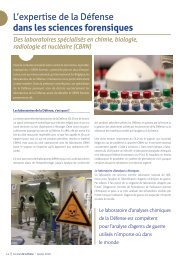Institute
XiXCVS
XiXCVS
Create successful ePaper yourself
Turn your PDF publications into a flip-book with our unique Google optimized e-Paper software.
with the EDA, the EASA, the European Space Agency (ESA), and EUROCONTROL have<br />
also contributed significantly in establishing airworthiness benchmarks for RPAS<br />
capabilities.<br />
What drives the backing of this new policy development? Is there a necessity-driven<br />
agenda in terms of new security challenges that justifies and calls for dual-use technologies<br />
and RPAS? One explanation for the EU’s policy shift in supporting unmanned aerial vehicles<br />
(UAVs) and RPAS development programs could be accounted for by their job creation<br />
potential. The aim would be to allow the European arms industry to become a global leader in<br />
the market of emerging technologies. In addition, it is argued that the development of<br />
disruptive technologies such as dual-use drones strengthens the robotics industrial base for<br />
civilian and commercial use, it encourages the development of systems engineering skills,<br />
and it calls for expertise in artificial intelligence. Not to mention the necessity of funding for<br />
dual-use R&T, as underlined by Chief Executive of the EDA, Mr Jorge Domecq, so as to<br />
avoid ‘spending twice’ and boost civil-military synergies. 13<br />
The goals and interests of the European Union and the defence industry have been<br />
increasingly converging, particularly now that the EU is set on consolidating its defence<br />
identity under the umbrella of the Common Security and Defence Policy (CSDP). In a study<br />
conducted on 100 arms-producing and military services, the Stockholm International Peace<br />
Research <strong>Institute</strong> (SIPRI) noted that out of the top 100 arms manufacturers, 30 are from<br />
Europe 14 and in the EU, more than 700,000 people work in the aerospace and defence<br />
industry. 15<br />
It is without any doubt that the major stakeholders in the defence industry have both<br />
the political and economic power to influence the EU’s policy agenda, especially due to the<br />
fact that there are overlapping interests in the partial and majority state ownership of EUbased<br />
companies, i.e. ‘Finmeccanica, which is partly owned by the Italian state; Thales,<br />
partly owned by the French state; and Airbus Group (formerly EADS), which is partly owned<br />
by the French state, German state and Spanish state.’ 16<br />
far, and what are the next steps to be made towards reaching a more efficient European airspace.’ Accessed<br />
September 25, 2015. http://www.eurocontrol.int/dossiers/single-european-sky<br />
13 The EDA, Latest News, ‘Exploring hybrid threats,’ September 25, 2015, Brussels. Accessed September 25,<br />
2015. http://www.eda.europa.eu/info-hub/press-centre/latest-news/2015/09/25/exploring-hybrid-threats<br />
14 M. Heinrich, ‘Elusive transparency in the EU: defence industry influence in Brussels,’ openDemocracy,<br />
February 2, 2015. Accessed September 25, 2015. https://www.opendemocracy.net/can-europe-make-it/markusheinrich/elusive-transparency-in-eu-defence-industry-influence-in-brussels<br />
15 A. Saini, ‘Building a Science Career in the Defence Industry,’ Sciencemag, May 22, 2009. Accessed<br />
September 25, 2015.<br />
http://sciencecareers.sciencemag.org/career_magazine/previous_issues/articles/2009_05_22/caredit.a0900067<br />
16 Ibidem



